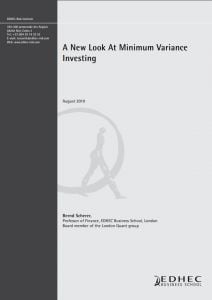

A New Look At Minimum Variance Investing
Disappointed with the performance of market-weighted benchmark portfolios yet skeptical about the merits of active portfolio management, investors in recent years turned to alternative index definitions. Minimum variance investing is one of these popular rule driven, i.e. new passive concepts. This paper shows theoretically and empirically that the portfolio construction process behind minimum variance investing implicitly picks up risk-based pricing anomalies. In other words the minimum variance tends to hold low beta and low residual risk stocks. Long/short portfolios based on these characteristics have been associated in the empirical literature with risk-adjusted outperformance (alpha). This paper shows that 83% of the variation of the minimum variance portfolio excess returns (relative to a capitalization-weighted alternative) can be attributed to the FAMA/FRENCH factors as well as to the returns on two characteristic anomaly portfolios. All regression coefficients (factor exposures) are highly significant, stable over the estimation period and correspond remarkably well with our economic intuition. A revisited version of this paper was published in the September 2011 issue of the Journal of Empirical Finance.
Author(s):
Summary:
Disappointed with the performance of market-weighted benchmark portfolios yet skeptical about the merits of active portfolio management, investors in recent years turned to alternative index definitions. Minimum variance investing is one of these popular rule driven, i.e. new passive concepts. This paper shows theoretically and empirically that the portfolio construction process behind minimum variance investing implicitly picks up risk-based pricing anomalies. In other words the minimum variance tends to hold low beta and low residual risk stocks. Long/short portfolios based on these characteristics have been associated in the empirical literature with risk-adjusted outperformance (alpha). This paper shows that 83% of the variation of the minimum variance portfolio excess returns (relative to a capitalization-weighted alternative) can be attributed to the FAMA/FRENCH factors as well as to the returns on two characteristic anomaly portfolios. All regression coefficients (factor exposures) are highly significant, stable over the estimation period and correspond remarkably well with our economic intuition. A revisited version of this paper was published in the September 2011 issue of the Journal of Empirical Finance.
Register to download PDF
Register/Log in| Type : | Working paper |
|---|---|
| Date : | 10/08/2010 |
| Keywords : |
Portfolio Management |

